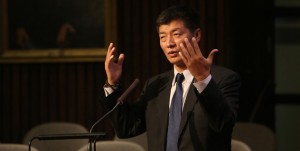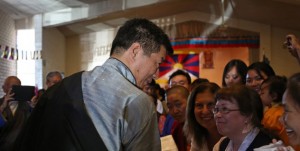Sikyong Dr Lobsang Sangay, took office as the sole political leader and the political figurehead of the freedom movement of the Tibetan community on August 8, 2011. On the same day this year, celebrations were held around the world in honour of not only the second anniversary of his time in office, but of the achievements he has made thus far.
Sangay has taken a fresh approach to garnering international attention for the Tibet issue, which presents real hope for a resolution to the situation in Tibet. He is fast becoming a well-known and internationally respected political leader, making a concerted effort to alter the image of the CTA to one of a functioning, democratic government in exile, and of the Tibet movement. This has involved extensive touring throughout the Western world where he hopes to foster earnest democratic, political discussion on the future of Tibet, not only between the Chinese Government and the CTA but also in the wider international community.
In Norway in May, Dr Sangay was invited to deliver a talk on “Democracy in Exile” at the 5th Oslo Freedom Forum, and in February, he was invited to present the first annual lecture of the Indian Association of Foreign Affairs Correspondents. By drawing a comparison between large international interest in the violent, contradictory “freedom fighters” in Syria and the lack of coverage of the non-violent, democratic Tibetan movement, he highlighted the discrepancy in media attitudes to democracy, saying “if non-violence is the right thing to do, we ought to be supported.”
In Dharamshala this month, the anniversary celebrations took the form of a prayer service in solidarity with self-immolators and their families, presided over by His Eminence the 17th Gyalwang Karmapa Ogyen Trinley Dorje. In his speech, Sikyong reaffirmed his commitment to pursuing the “Middle Way Approach” and improving dialogue with the Chinese government and international media. He praised the Kashag and Tibetans inside and outside Tibet for their roles in the successful transfer to democracy. He also thanked international support groups for their work raising awareness of the situation abroad which has stimulated many foreign governments to formally address the human rights abuses in Tibet. He was keen to impress upon his audience that although he understood that Tibetans within Tibet had no other means of protest, self-immolation was not the best way to campaign for freedom. He urged Tibetans to find unity in this time of difficulty.
Further afield, in Russia, Tibet House in Moscow held an evening of discussion and debate centred around their translation of the white paper “Why Tibet Is Burning” and a screening of a recent interview with the Sikyong conducted by a national Russian TV channel. Sikyong was praised for his “courageous platform of non-violence, respect and compliance with legality” and deemed him “a worthy example of embodiment of the principles of justice, humanity and democracy”. Further West, several American centres for Tibetan community interests held prayer services to mark the occasion.
On March 10, 2011, His Holiness the XIVth Dalai Lama devolved political power to the leadership of the Central Tibetan Authority (CTA). This act was globally recognised as an extremely promising step towards democracy, and demonstrated that the Dalai Lama and the Tibetan Government in Exile were attuned to the realities of governance and modern politics. In September of the following year, the title of Dr Sangay’s office was changed from Kalon Tripa to Sikyong – a change which can be seen as symbolic of the new direction which his tenure has taken. The previous title translates to “Chief of Cabinet”, and was the highest political office which could be held by a lay person. The title of “Sikyong” denotes the main political leader, and was previously held by the His Holiness himself. This transfer of title has proven to be key in the evolution of the freedom movement, and demonstrates the Dalai Lama’s faith in Sangay’s leadership.
Sikyong Lobsang Sangay has three more years left in office.






 Print
Print Email
Email